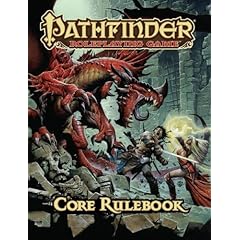As I mentioned in a prior post, I’d like to integrate Monte Cook’s Arcana Unearthed ruleset with the recently released Pathfinder ruleset. I really like the magic system and the flavor of the world is not to be missed. One of the first things that I felt needed to be integrated is the feat system, so I went throw the rulebook feat by feat and compared the feats to what is currently offered under the Pathfinder Rules set.
Monte Cooke had introduced a couple of new concepts in his Arcana Unearthed rules: Ceremonials Feats and Talents. The world of Arcana Unearthed utilized a lot of ceremony and ritual, and Monte classified these feats to codify the rule significance of going through certain ceremonies. From a rules point of view, these feats don’t really pose any problem being directly translated over to Pathfinder rules. Monte Cook called for giving every race an additional ceremonial feat at first level, but that’s not because Ceremonial Feats were categorically weaker. Ceremonial feats are just as powerful if not more powerful than the other feats, so they pose no problem in doing a straight across feat for feat integration.
Talents, however, are a different story. In the Unearthed Arcana rules system, a talent was a feat that could only be taken at first level. Because of this restriction, he made a talent slightly stronger that other feats. For instance, Monte’s version of Skill Focus gives a +3 bonus to the selected skill, while the talent Affinity with Skill gives a +4. Note that the Skill Focus feat was one of many departures from the existing 3.0 D&D rules (which only gave a +2 bonus for Skill Focus at the time) that would later be officially added into the 3.5 or Pathfinder revision. Unearthed Arcana has a many such ideas that, even today, represent a significant step forward for the Pathfinder rules set; my absolute favorite among them is a completely unified magic system.
For the Pathfinder Rules, Monte Cook’s talent feats are actually very simply to integrate because Pathfinder has, essentially, adopted their conventions. In the Pathfinder Adventure Path: Council of Thieves #1 – The Bastards of Erebus, there is an extensive right up on tieflings that includes a few feats that allow you more variation in the character creation stage. These tiefling-related feats have to be taken at first level, which makes then exactly the same as talents. Furthermore, Pathfinder has added traits, which are essentially “half feats” that must be taken at first level. Since Pathfinder recommends two traits (or half-feats) at character creation, you can easily add Monte Cook’s talent feats as simply “double traits.” That is, instead of getting two traits, you’d get one of the talent feats.
With these conventions, you can adopt the entire Unearthed Arcana feat system under the Pathfinder rules. Continue reading Converting Monte Cook’s Arcana Unearthed Feats to Pathfinder



